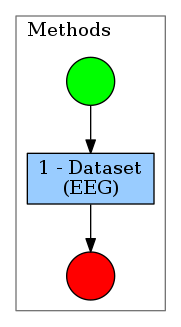20 participants
A total of 20 healthy volunteers (9 female, mean age 30, standard deviation 6.8, 18 right handed) was evaluated. All the volunteers did not have any neurological pathology.
Main step: Set of steps
-Identification: Methods
-Description: Experimental protocol
The experiment consisted in exposing volunteers to sequences of auditory stimuli defined as strong beats, weak beats and silent units, indicated respectively by symbols 2, 1 and 0. The sequence of auditory stimuli were produced by the Ternary and Quaternary chains.
Besides the Ternary and Quaternary chains we also used sequences of independent auditory stimuli taking the values 0,1 and 2 with probability 1/3. The goal of introducing this i.i.d. sequence of stimuli was to shuffle cards before the volunteer is exposed to a next sample.
The volunteer was exposed to two 12 min blocks of samples generated by each one of the three stochastic chains. The blocks were separated from each other by a period of time ranging from 5 to 10 min, during which data collection was interrupted.
Each sample was a concatenation of three 1 min sequences of auditory units generated independently by the same stochastic chain. Each sequence of auditory units was separated from the next one by a 15 seconds silent interval.
All volunteers were exposed to two different orderings, either Ternary, Independent, Quaternary
or Quaternary, Independent, Ternary.
For half of the volunteers the starting block was Ternary, Independent, Quaternary and the second block was Quaternary, Independent and Ternary. The inverse ordering was used with the other half, to balance possible order effects.
Presentation software (Presentation Mixer as a Primary Buffer and a Sound card: SoundMAX HD Audio) was used to play the auditory sequences through a headset. The loudness of the stimuli was individually regulated before the experiment start by presenting the strong beat and asking the volunteer to adjust it up to a comfortable level (Range: 0.1-0.3 dB).
Data acquisition and pre-processing
EEG recording was performed by means of a 128 channels system (Geodesic HidroCel GSN 128 EGI, Electrical Geodesic Inc.). The electrode cap, previously immersed in saline solution (KCl), was dressed into the volunteer's scalp. Volunteers were instructed to close their eyes and remain quiet throughout the experiment.
The EEG signal was amplified with a nominal gain of 20 times. The acquisition was performed in a sampling frequency of 250Hz. During acquisition the signal was analogically filtered (Butterworth first order band-pass filter of 0.1-200Hz; Geodesic EEG System 300, Electrical Geodesic Inc.). The electrode positioned on the vertex (Cz) was used as reference.
The data was preprocessed offline using EEGLAB (\cite{Delorme-eeglab:04}) running in MATLAB environment (MathWorks, Natick, MA, version R2012a). Signals were filtered with a Butterworth fourth order band-pass filter of 1-30 Hz. Artifacts above and below 100 $\mu$V were removed. The data was then segmented into events of 450 ms, each one indexed by the corresponding auditory unit. Finally, baseline correction was performed using the signal collected 50 ms before each event starts.
Participants
A total of 20 healthy volunteers (9 female, mean age 30 y., standard deviation 6.8 y., 18 right handed) was evaluated. None of them have reported any neurological pathology. The volunteers signed a informed consent term, after the nature of the study had been explained.
Reference: Context tree model selection for functional data, https://arxiv.org/abs/1602.00579
-Type: Sequence
-Sub-steps: (1)
Step 1: EEG
-Identification: Dataset
-Number of repetitions: 1
-Order: 1
-Position in the set of steps : Fixed
-Requires start and end datetime: No
EEG Settings
- 128 channels system, Geodesic HidroCel GSN 128 EGI, Electrical Geodesic Inc.
Amplifier: Net Amps 300 amplifier The Net Amps 300 series of amplifiers powers the new Geodesic EEG system (GES) 300 series products. serial number: 123412341234
gain: 20.0
gain setting: 20.0
sampling rate: 250.0
number of used channels: 128



